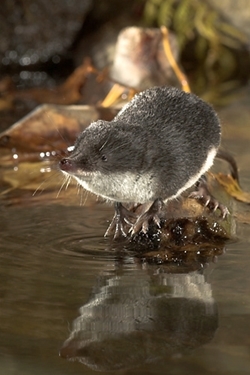Water shrew
 I knew very little about the water shrew before writing this account, but I am now convinced that it’s one of Britain’s quirkiest animals. Who knew that we had a venomous, red-toothed mammal wandering about the countryside that tastes horrible to predators and can anchor itself underwater?
I knew very little about the water shrew before writing this account, but I am now convinced that it’s one of Britain’s quirkiest animals. Who knew that we had a venomous, red-toothed mammal wandering about the countryside that tastes horrible to predators and can anchor itself underwater?
The Eurasian water shrew (Neomys fodiens) is widespread in Europe and northern Asia and is named for its close association with wetland habitats such as ditches, ponds, river meadows and outdoor aquatic farms. Watercress farmers may well have encountered one, but I bet the majority of people have not, for it is secretive and elusive.
Water shrews might get confused with water voles to the distant observer, and perhaps even brown rats, which can occupy the same habitats. But they are really quite different up close if you excuse the tail. Shrews have a tapir-like elongated nose, tiny eyes, more or less invisible ears and dense, felty fur. They leave few field signs – unlike water voles, which leave droppings and dinner leftovers all over the place.
One of three species of shrews native to Britain, the water shrew is the largest at 15cm long including the tail. Unlike the common shrew and pygmy shrew, which are less than 10cm long with brownish grey pelts, the water shrew has black, mole-like upper fur and a silvery belly, though the colouration can vary.
The first trick of many in the water shrew’s book is an ability to dive up to two metres deep in pursuit of prey: proportionally, this is like a human diving 20 metres! They have a wide diet consisting of aquatic insect larvae, molluscs, crayfish, amphibians, small rodents, fish and spiders, which they catch and eat with sharp, red-tipped teeth. They are red because the enamel is fortified with iron, and this extra strength may come in handy on tough exoskeletons of crayfish.
For the larger prey items, venomous saliva comes in useful for subduing the catch. The toxins are strong enough to stun a field vole, and a bite can cause irritation and redness in humans, but it won’t take you out.
Another clever feature is a very dense coat, which traps air bubbles. It forms a barrier between the skin and cold water, allowing them to swim in winter months, which is important because they don’t hibernate. Of course, this buoyancy can backfire slightly because they have to paddle furiously to avoid floating to the surface! Cue another trick, which is an ability to anchor itself to submerged vegetation using its tail, in order to stay underwater.
They can close their white-tufted ears when diving, and they navigate using a keeled tail, which acts like a rudder. Sensitive whiskers help to locate prey when swimming because their eyesight is pretty poor.
Their burrows are excavated in riverbanks and have a specially designed entrance, no more than two centimetres in diameter. The hole acts like a mop wringer and squeezes the water out of their coats, then the shrew finishes off the job by grooming itself with the bristly hind feet.
Water shrews live a solitary life, and do not bond with others. Females hold territories between April and September and males merely visit for mating, playing no role in the upbringing of the litter. June is the peak of the breeding season, when mothers will be busy feeding a litter of up to 15 young in burrows. They do not have a long lifespan in which to breed – 18 months is average – so they become sexually mature at only three months old and get going.
Water shrews have several natural predators including foxes, big predatory fish, raptors and cats. However, they sometimes have the last laugh because they can produce a foul-smelling oil from scent glands on their body, making them unappetising, so if the predator didn’t do too much damage on first bite the shrew might be spared its life.
Finally, a general note on shrews. You might think that shrews are rodents, but in fact they’re no closer to being a rodent than you are. Along with moles and hedgehogs, they are actually members of the Eulipotyphla order (uncourteously, this means "truly fat and blind"). As for lineage, it is thought that the common ancestor of all warm-blooded placental mammals including humans was a shrew-like, insect-eating creature almost 65 million years ago, shortly after the dinosaurs went extinct, so they may have a longer claim on the earth than many other mammals!
I think the water shrew, with all its neat tricks, is a pretty satisfying achievement for 65 million years of evolution, and I really hope you and I are lucky enough to see one someday.
Jess Brooks
Advisory
Photo credit: Jeroen van der Kooij